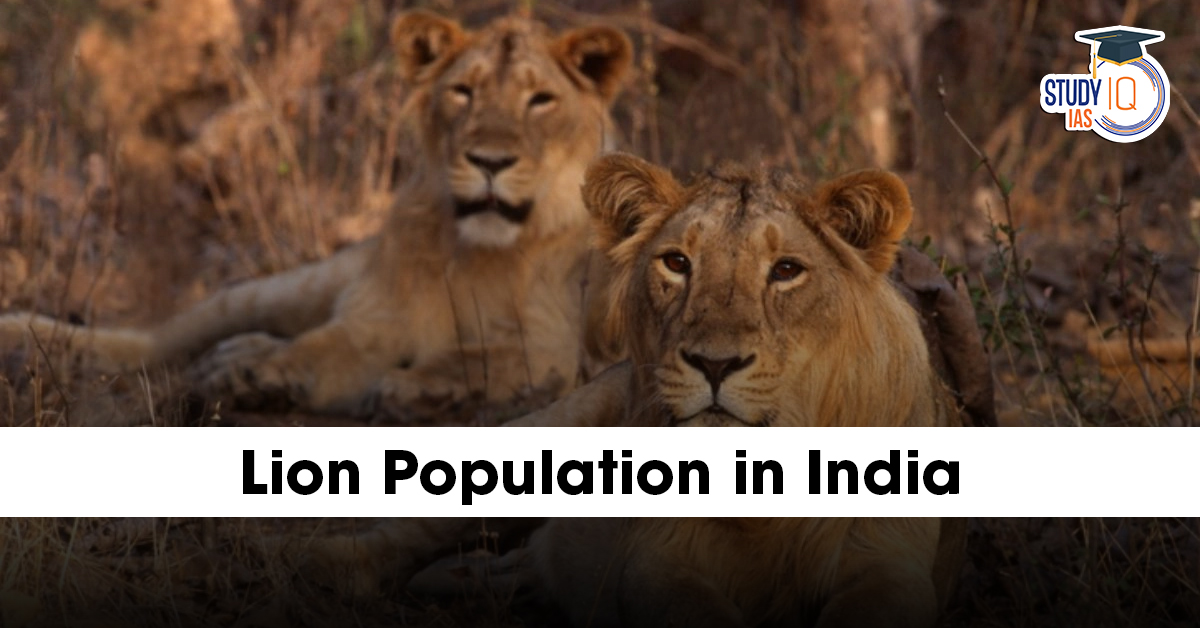Table of Contents
Context: According to the Gujarat Forest Department report, India’s lion population in Gujarat has increased by 32% (891 lions) between 2020 and 2025. India’s Asiatic lion population has grown from 674 in 2020 to 891 in 2025, a 32.2% increase, per the 16th Lion Population Estimation report.
Lion Population in India
India is the only home of the entire Asiatic Lion (Panthera leo persica) population of the world, and thus, their conservation is of greatest international significance. These regal big cats are now resident only in the state of Gujarat, mainly inside and around Gir National Park and Wildlife Sanctuary.
Lion (Panthera Leo)
- Lions are the second-largest cat species in the world.
- It is divided into two subspecies: the African lion and the Asiatic lion (Persian or Indian Lion).

Latest Lion Population Figures (16th Asiatic Lion Census 2025)
As per the recent census, the 16th Asiatic Lion Population Estimation (2025), published on May 21, 2025, by the Gujarat Forest Department:
- The overall number of Asiatic Lions in Gujarat has grown to 891.
- This is a notable increase of 32.2% from the 674 lions counted in the last census in 2020.
- The census, which was done between May 10 and May 13, 2025, traversed a large area of around 35,000 square kilometres in 11 districts of the Saurashtra region.
- Out of the total, 384 lions occurred within the protected forest and sanctuary habitats, and 507 lions occurred in habitats outside their boundaries, such as revenue areas, coastal belts, and lion corridors. This shows an increasing spread of the lion population into newer habitats, including the Barda Wildlife Sanctuary.
- The population comprises 196 adult males, 330 adult females, 140 sub-adults, and 225 cubs.
|
Difference between the African lion and the Asiatic lion |
||
| Feature | African Lion (Panthera leo melanochaita) | Asiatic Lion (Panthera leo persica) |
| Size | Larger than the Asiatic lion | Slightly smaller than the African lion |
| Mane | Males have shorter, sparser, and darker manes | Males have a fuller and more uniform mane |
| Social Behavior | Males live separately from the pride unless mating or during a kill | Males stay with the pride, forming a tighter social unit |
| Distribution | Found in Sub-Saharan and West Africa | Gir National Park, expanded to Barda Wildlife Sanctuary, surrounding areas in Gujarat, India |
| Habitat | Adapted to forest, savanna, shrubland, grassland, and desert | Lives in dry deciduous forests |
| IUCN Red List Status | Vulnerable | Endangered |
| CITES Status | Appendix II | Appendix I |
| CMS Status | Appendix II | Appendix II |
| Indian Wildlife Protection Act | Not applicable | Schedule I (Highest protection under Indian law) |
Conservation Efforts and Project Lion
The increase in the lion population is a testament to the sustained and successful conservation efforts undertaken by the Gujarat Forest Department and the Indian government. Key initiatives include:
Project Lion
Launched in 2020 by Prime Minister Narendra Modi, Project Lion is a long-term conservation program aimed at securing the future of Asiatic Lions by:
- Enhancing habitat management and protection.
- Implementing advanced wildlife health monitoring.
- Engaging local communities in conservation efforts.
- Developing additional suitable habitats beyond Gir National Park, like the Barda Wildlife Sanctuary, to support genetic diversity and reduce population pressure.
Direct Beat Verification Method
The census primarily relies on this method, which involves direct sightings by thousands of personnel, including forest officials, enumerators, and volunteers. Modern tools like high-resolution cameras, camera traps, and GPS-enabled radio collars are also utilized.
Community Coexistence
The growing presence of lions outside traditional protected areas highlights successful coexistence models between humans and lions in the region.
Challenges and Future Outlook
Even with the optimistic growth, problems exist:
- Genetic Bottleneck: Since the whole population has been limited to one geographic area, there is a risk of inbreeding genetically and exposure to epidemics or natural catastrophes. Work continues towards creating a second viable population.
- Human-Wildlife Conflict: With their expansion into human-dominated landscapes, human-lion interaction management and conflict reduction are important.
- Habitat Fragmentation: Maintaining habitat connectivity and safeguarding corridors for the lion’s movement is crucial to their eventual survival.
The growth in the lion population of India is a conservation triumph, showing that focused protection programs and community participation can be effective. But vigilance and strategic planning must continue to preserve the prosperity of the Asiatic Lion.


 Bonnet Macaques: Habitat, Features, Beha...
Bonnet Macaques: Habitat, Features, Beha...
 Periyar Tiger Reserve, Map, Flora, Fauna...
Periyar Tiger Reserve, Map, Flora, Fauna...
 Project Cheetah in India, Objectives, Ch...
Project Cheetah in India, Objectives, Ch...

























